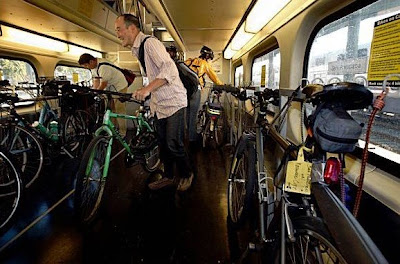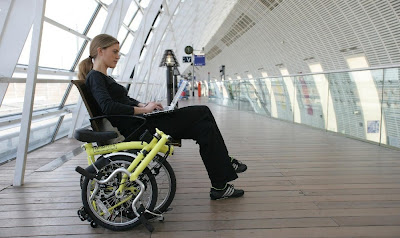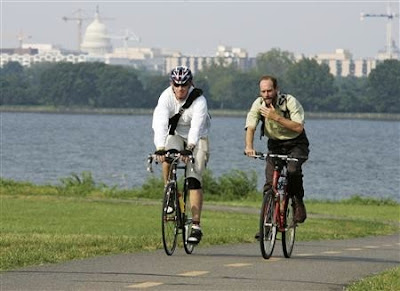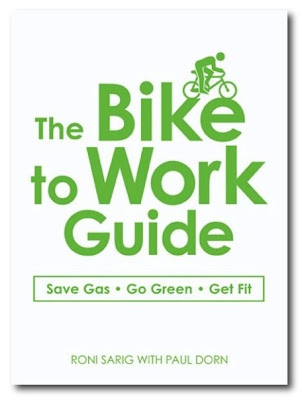
Saw this interesting sticker on a bicycle during my morning commute today. The sticker indicated it came from CarFreePortland.org, an organization doing worthy work to fight autodependency. Great sticker.
Of course, another truly great sticker is the increasingly popular ZeroPerGallon decal, as featured on my Bianchi hybrid bicycle. Very timely, and a great way to gently taunt your SUV-driving acquaintances.
Image: Paul Dorn
Visit: It's not just a bike, it's a statement, Bike Commute Tips Blog
Visit: So, like, who's Jim Morrison, Bike Commute Tips Blog
Visit: Removing Bicycle Decals, Instructables
Visit: Paul Dorn's Bike Commuting Tips Site
Amazon iframe
Thursday, October 23, 2008
Live Free or Drive
Tuesday, October 21, 2008
University programs promote bicycling

From the New York Times, 10.19.08:
With Free Bikes, Challenging Car Culture on CampusUniversity students are prime recruits for bicycle commuting: young, relatively fit, cash-poor. (Unfortunately, some insecure college students are also vulnerable to the illusory ego-boosting image of car culture.) As an employee at the most bicycling intensive campus in North America--the University of California, Davis--I've been very happy to see the bike promotion initiatives popping up at university campuses across the U.S. This article from the New York Times provides a great summary.
BIDDEFORD, Me. — When Kylie Galliani started at the University of New England in August, she was given a key to her dorm, a class schedule and something more unusual: a $480 bicycle. “I was like, ‘A free bike, no catch?’ ” Ms. Galliani, 17, a freshman from Fort Bragg, Calif., asked. “It’s really an ideal way to get around the campus.”
University administrators and students nationwide are increasingly feeling that way too. The University of New England and Ripon College in Wisconsin are giving free bikes to freshmen who promise to leave their cars at home. Other colleges are setting up free bike sharing or rental programs, and some universities are partnering with bike shops to offer discounts on purchases.
The goal, college and university officials said, is to ease critical shortages of parking and to change the car culture that clogs campus roadways and erodes the community feel that comes with walking or biking around campus.
“We’re seeing an explosion in bike activity,” said Julian Dautremont-Smith, associate director of the Association for the Advancement of Sustainability in Higher Education, a nonprofit association of colleges and universities. “It seems like every week we hear about a new bike sharing or bike rental program.”
Here at the University of New England, officials wonder what will happen when snow starts falling, but they are looking toward bike-sharing programs in cities like Copenhagen and Montreal as proof that they can work in the cold.(Read more.)
Other higher education initiatives of interest include Michigan State University's bike leasing project; the seven-year-old "cruiser co-op" at the University of Montana; the Ramwheels program at Colorado State University; the used bicycle recycling efforts at Framingham State University; and the bike lending program at the University of Missouri Kansas City.
Other bicycling programs in academia? If you are a university student, faculty, or staff, what is your campus doing to encourage or discourage bicycle use? Any suggestions for encouraging college students to persist with bicycling after they graduate?
Image: University of New England. Bikes are labeled with student names.
Visit: No cars, free bikes for UNE freshmen, Portland Press-Herald
Visit: UC San Diego Campus on Fast Track to Fewer Cars, Newswise
Visit: Bicycle program booming at the University of South Carolina, Island Packet (Hilton Head)
Visit: Cal's Green Bike Share Program, PlayGreen Blog
Visit: Administrators consider instituting project for campus bicycle use, Murray State News (Kentucky)
Visit: SPOKES students put the fun between their legs, The Martlet
Visit: Colleges use rewards to entice students, staff to go green, San Diego Union-Tribune
Visit: Class aims to promote bicycling, The Oxford Press (OH)
Visit: Campus loans out dumped bicycles, Seattle Post-Intelligencer
Visit: On-campus bike use proves helpful for environment, Daily Campus (University of Connecticut)
Visit: Bike co-op makes campus commute quicker, easier, The Hawk (St. Joseph's University, Philadelphia)
Visit: Bikes made fashionable for college, Bikes Commute Tips Blog
Visit: David Takemoto-Weerts: The collegiate cycling environment, Bike Commute Tips Blog
Visit: Colorado study on collegiate helmet use, Bike Commute Tips Blog
Visit: Paul Dorn's Bike Commuting Tips Site
Wall Street Journal: Cycling in London
Interesting report from London, suggesting economic factors and supportive public policy are leading to more bicycling for transportation. According to research cited in this video, the biggest barrier to people traveling by bike is anxiety about "helmet hair" and perspiration. Really? Not safety or secure parking, but coiffure and sweat? Solution might be to ride slow without a helmet, hmmm?
Visit: Is Britain really getting on its bike, Bike Commute Tips Blog
Visit: London announces bicycling encouragement plan, Bike Commute Tips Blog
Visit: Morning bike commute in London, Bike Commute Tips Blog
Visit: Massive rise in London cyclists, Bike Commute Tips Blog
Visit: Paul Dorn's Bike Commuting Tips Site
Thanks to Jack Painter for the story link.
Monday, October 13, 2008
Amtrak's Capitol Corridor adds bicycle capacity
Interesting discovery on my ride home this evening on the Amtrak Capitol Corridor. The car I was on had a new bicycle rack, with space for seven bikes. Six passenger seats had been removed to install the racks.
I use the Capitol Corridor daily, bicycling less than a mile to the Sacramento Valley Station, taking the train 16 miles to Davis, and bicycling 1.5 miles to my office at UC Davis. (Most days I bicycle home, about 17 miles.)
The Capitol Corridor has attracted record ridership the past few months, including more bicyclists squeezing into the existing on-board bicycle storage space. When the three vertical spaces in most standard cars have been full, the conductors have indulged overflow bicycles, a special problem on the commute-hour trains between Sacramento and Davis. This crowding prompted me to buy a Giant Halfway folding bike, in anticipation of eventual Caltrain-style bicyclist bumping when on-board capacity limits are reached.
The Capitol Corridor is an outstanding service for multimodal bike commuters. From the Capitol Corridor website: "Bicycles are welcome aboard Capitol Corridor trains. You can find bicycle racks on the lower level of most coach cars. If all racks are full, notify the conductor. The conductor will identify a place for you to safely secure your bike. Please carry a bungee cord with you, to use in securing your bike."
Many of the bicyclists bringing their bikes on-board the Capitol Corridor might prefer not to. Secure bicycle parking is sadly lacking at most Capitol Corridor stations. BikeStation style bike parking facilities would certainly attract many bicyclists, especially in Sacramento, San Jose, and Oakland.
As gas prices trend higher in the long-term, more multimodal bicycle commuters will be crowding on board transit. It's great to see some innovative thinking to expand capacity.
Images: Paul Dorn
Visit: Have your bike and ride it, too, Mother Earth News
Visit: Loading bike on train requires feat of strength, Arizona Republic
Visit: Bikes crowding onto transit, Bike Commute Tips Blog
Visit: Bikes on Board Amtrak's Capitol Corridor, Bike Commute Tips Blog
Visit: Amtrak Capitol Corridor celebrates 15 years, Bike Commute Tips Blog
Visit: Paul Dorn's Bike Commuting Tips Site
Saturday, October 11, 2008
More press for Bicycle Commuter Act

From the San Jose Mercury-News, 10.11.08:
Bailout delivers benefit to bike commutersLast week President Bush signed the rush-job Emergency Economic Stabilization Act, better known as the hasty $700 billion Wall Street bailout. And now the details of this panic measure are being revealed, with the media giving necessary attention to the worthy if modest benefits granted bicycle commuters.
Bicycle commuters across the nation will be eligible for a tax benefit already available to bus and train riders under an 11th-hour addition to the $700 million federal bailout for finance industries
Effective Jan. 1, people who use bicycles as their primary means of getting to work will be eligible to get up to $20 a month in tax-free payments from their employers for the costs of owning and operating a bike. Employers can deduct the payments as an expense from their federal taxes.
Bike enthusiasts in Congress had tried to pass the tax benefit for bicyclists for several years, but were unable to win approval from the Senate until negotiations over the bailout package approved earlier this month.
"What this does is to legitimize commuting by bicycle," said Robert Rayburn, director of the East Bay Bicycle Coalition. "We've already seen a swelling of bicycling commuters on account of the rising gas prices. Until this change in the tax code, bike commuters have been denied a benefit that public transit riders get." (Read more.)
The act changes the tax-code, effective in January, allowing companies to give up to $20 a month to workers who pedal to work, which the employees could use for tires, lights, helmets, locker rental fees, or shower access at a gym. It would be tax-free to cycling commuters, and a tax write-off for employers.
"It's sort of an equity thing," Andy Clarke, executive director of the League of American Bicyclists, told the Arizona Republic. "People who take transit and park their cars already get tax breaks."
Expressing a sentiment felt by many bicycle commuters, Walt Seifert, executive director of Sacramento Area Bicycle Advocates, told the Sacramento Bee: "It's about time. I hope employers jump on the chance to offer it." Jonathan Maus, editor of BikePortland.org, told the New York Times: "It’s a pretty small victory. But this gives a lot of people around the country the ability to walk into their human resources office or their manager’s office and ask for the credit. It helps move the conversation forward."
The media coverage is welcome, because as Maus indicates, the measure only provides an opportunity for an employer tax benefit. It is still up to employers to implement the subsidy, and bicycle commuting employees to demand it. Raising awareness of the measure's benefits to bicycle commuters is critical. As gas prices continue to increase, a $20 monthly incentive is an appealing additional inducement to potential bicycle commuters.
Beyond expensive gas, Americans will be further pinched in future years by collapsing home values, a weaker dollar, diminished retirement accounts, and anxiety about employment. Saving money on transportation will become a big imperative in many households, meaning bicycle commuting will only be more attractive.
Instead of bailing out greedy, irresponsible, and reckless bankers, I wish the Feds had invested in job-creating public works projects, such as transit, pedestrian, and bicycling infrastructure. More bicycle commuters will only mean increased crowding at bike racks and lockers, on the bike trails, on trains and buses. We need more public investment in sustainable transportation. Now.
Image: Web capture.
Visit: Bicycle Commuter Tax Provision: Frequently Asked Questions, League of American Bicyclists
Visit: Bailout bill has biking benefit, Columbus Dispatch
Visit: Buried in the Bailout: The Bicycle Commuter Act, New York Times
Visit: Bailout gives tax break to bicycle commuters, San Francisco Chronicle
Visit: Bailout has a boost for bike commuters, Sacramento Bee
Visit: Bicyclists will benefit from $700 billion bailout, Arizona Republic
Visit: Reimbursement for Bike Commuters Included in Bailout Bill, SustainableBusiness.com
Visit: Tax benefits for commuter cyclists, Austin360.com
Visit: Bicycle Commuter Tax Break Is a Bittersweet Victory for Measure’s Sponsor, New York Times
Visit Employers, Workers Could Benefit From New Program, WISC-TV (Madison, WI)
Visit: Paul Dorn's Bike Commuting Tips Site
Thursday, October 09, 2008
Bicycle travel, with children too!

From the Oregonian, 10.09.08:
Have kids? How you can still travel via bikeMany would-be bicycle commuters have the challenge of needing to transport kids; and many bicycle commuters are children on their way to school. This article from Portland offers a great overview of bicycle travel options with children, considering options such as tandems, trail-a-bikes or tag-alongs, trailers, bicycle seats, long-frame utility bicycles, and the fun-to-ride Bakfiet. No matter how old your child is, there is a way to bicycle commute with kids.
It's no secret that Portland has a love affair with bicycles, but what to do when your kids are too young to ride on their own? With all the fun and functional new biking systems on the market, becoming a parent doesn't mean you have to let your bicycle grow cobwebs. There's a rig for every family, from the simple and relatively inexpensive baby seat to the snazzy Bakfiet, a Dutch cargo bike made for serious hauling.
Best choices for babies and toddlers are attachable seats, trailers or the cargo bike. At age 4 or 5, children may be ready to try a tag-along, family tandem or an Xtracycle. While there's no hard and fast rule for when to switch kids to a more independent riding system, Martina Fahrner, co-owner of CleverCycles in Southeast Portland, offers some advice. "You really need to use your parent instinct," she says. "You know your child's development and what they're comfortable with." (Read more.)
This is the kind of story we can only hope to see more of in the major media, with practical "how-to" information on bicycling for transportation. Americans are likely to be relatively poorer in the next few years. Gas prices are unlikely to go down, especially with an increasingly weaker dollar. The new Bicycle Commuter Act passed by Congress offers a possible cash inducement to bicyclists. Together, these factors among others mean more people will be looking very seriously at the bicycle as a means of transportation in future months. They'll be grateful for helpful articles such as this one.
Image: The Oregonian.
Visit: Twelve tips for bicycling with children, Marion Star (OH)
Visit: Kids and biking, San Francisco Chronicle
Visit: Car-Free Families Blog, BikePortland.org
Visit: Fitness: Safe bicycling for children starts at home, News Press (Ft. Myers, FL)
Visit: Auto traders: Families who give up their cars like the savings--and their life in the slow lane, Boston Globe
Visit: Bicycling With Children: A Complete How-To Guide
Visit: Bicycling with Children, Blue Island Bicycle Club
Visit: The biking parent: Interview with Jon Winston, Bike Commute Tips Blog
Visit: Paul Dorn's Bike Commuting Tips Site
Tuesday, October 07, 2008
Folding bikes for crowded transit

From the Argus (Fremont, CA), 10.06.08:
Folding bikes: a transit alternativeGreat article on the appeal of folding bicycles for multimodal commuting. According to this article, folding bicycles account for less than 1 percent of the 18 million bicycles sold each year in the U.S. However, the market is growing in response to higher gas prices and increased interest in urban living.
IT'S NOT JUST the money she saves on gas that makes her folding bike appealing to Ellen Babcock on her BART ride to work in Oakland. "I like it because it packs up into a little package. I like it because I can ride on BART any time," said Babcock, who rides her bike to a San Francisco BART station. After getting off at the Rockridge station, Babcock pedals to her job of teaching sculpture at the Oakland campus of the California College of the Arts. "It's just so much more pleasant than being in a car," she said.
Taking a folding bike on BART does invite curious inquiries from fellow passengers, she said. That's no surprise given their unique look. Their smaller wheels and high seat and handlebars set them apart from regular, full-sized bikes. While regular bikes have wheels with a diameter of 26 inches, most folding bikes have 16- to 20-inch wheels.
"Folding bikes are not the most chic thing. They are more practical," said BART spokesman Linton Johnson. "They are very good for commuters who want to save on gas and are just going from Point A to Point B. We are seeing a lot more people turning to bikes to save on a gallon of gas, and folding bikes are the way to go." (Read more.)
Crowding aboard transit in my region led me to acquire a great Giant Halfway folding bicycle earlier this year. It's a very handy bicycle, easily toted into the office, tossed in vehicle trunk, or brought on a bus.
Image: Web capture.
Visit: Know when to fold 'em, Boston Globe
Visit: The Best of the Best: Folding Bikes, ecogeek
Visit: Downtube Folding Bicycles
Visit: The Folding Bike Solution, Transportation Alternatives
Visit: Paul Dorn's Bike Commuting Tips Site
Sunday, October 05, 2008
Bike Commuter Act part of Fed bailout bill

From Bicycle Retailer & Industry News, 10.02.08:
Congress Passes Commuter ActA number of blogs have already commented on the inclusion of the Bicycle Commuter Act into the ridiculous $700 billion Federal pork barrel bailout of Wall Street, including great coverage by Cyclelicious, BikePortland.org, StreetsBlog, and a survey of bicycle commuting attitudes by Outside Online. The bicycle commuter provisions of the bailout have also aroused hostility in less supportive quarters, summarized by Philadelphia Bicycle News:
WASHINGTON, DC (BRAIN)—Employers of people who bike to work stand to gain a $20 per month tax credit per cycling employee, according to the final version of the Wall Street bailout bill, H.R. 1424, passed this afternoon...
What does bicycle commuting have to do with credit issues or covering the debt racked up on Wall Street? Bicycle commuting advocate Earl Blumenauer, a Democratic Representative from Oregon, was one of the 228 Representatives who voted against the House version of the bailout package on Monday. House members looking to pass a bailout bill needed to convince as least 12 of the dissenters to switch their position and vote for a bailout bill...
Congressman Blumenauer spearheaded a seven-year campaign to extend commuter tax benefits to those who bike to work. Andy Clarke, president of the League of American Bicyclists, said the Bicycle Commuter Act has been held up getting through with previous bills. “It’s been attached to a variety of different bills or devices—climate change, energy, transportation,” Clarke said. “It’s ironic that it would wind up in a financial rescue package, but we’ll take it. I’m not going to quibble with the method; I’m glad to see it done.” (Read more.)
"Bicycles are in the headlines today, but not in a good way. (The) Bicycle Commuter Act is tied into the Tax Bailout Bill lumping bicycle commuters with Rum Makers and tax breaks for NASCAR. They are labeling the Bicycle Commuter Tax Break as Pork, does this mean that Transit Check and commuter parking benefits are also Pork?"As I understand it, the Bicycle Commuter Act provides employers a tax break of up to $20 a month if they give some bicycle commuting benefits to their employees. It's a modest step forward. "It may not be a total game changer," the LAB's Clarke told Bicycle Retailer & Industry News. "It's still a relatively small break. But it gets us closer to the kind of treatment that cyclists in the U.K. and other parts of the world have had for years."
This measure may attract a few additional bicycle commuters. Personally, I would have preferred that $700 billion spent on beneficial economy stimulating public works projects, such as passenger rail, bicycle facilities, and transit. However, this bailout will likely have another more significant favorable effect. Essentially, the Fed policy seems to be dollar devaluation, reducing the debt crisis through inflation. This can only mean even higher prices for gas, increasing the relative appeal of bicycle commuting.
Image: Web capture.
Visit: Congressional Bike Caucus
Visit: Bailout Bill Gives Bicyclists a Tax Break, Wired.com
Visit: Bicycle Bailed Out, New Haven Independent
Visit: Bailout passes with Bicycle Commuter Act attached; Bush signs it, BikingBis.com
Visit: Bicycle Commuter Act Becomes Law, Los Alamos Bikes
Visit: Adventures of the Bike Commuter Act, Discovering Urbanism
Visit: Paul Dorn's Bike Commuting Tips Site
Saturday, October 04, 2008
Utility bicycles make sense

From the Los Angeles Times, 10.06.08:
Sport utility bikes: a comparison
When gas prices gushed over $4 a gallon earlier this year, bike shops were (and still are) swamped with people who suddenly wanted to use pedal power for commuting, socializing and shopping. Attracting particular attention are so-called "longtails"--extra-long SUBs (sport utility bikes) with welded-on racks designed to haul big, bulky cargo, whether it's a 200-pound load of bricks, surfboards or three or four bags of groceries. Here's a look at four of the most popular SUBs I tested at the recent Interbike trade show in Las Vegas. (Read more.)
Cyclist and author Roy M. Wallack (Bike for Life: How to Ride to 100
Like any commuter, bicycle commuters need to carry things: lunch, a change of clothing, work files, paperwork, a laptop computer, tools, a gift for a colleague, or other materials. For most of my commuting, I make do with a rear rack and panniers. Occasionally I use my Timbuk2
Image: Los Angeles Times.
Visit: Interbike: Urban gear for hauling and looking sharp, BikeRadar.com
Visit: Who needs a trunk?, Bike Commuting Tips Blog
Visit: Interview with Lane Kagay of CETMARacks, Bike Commute Tips Blog
Visit: Getting Started: Carrying Capacity, Bike Commuting Tips Site
Visit: Paul Dorn's Bike Commuting Tips Site

